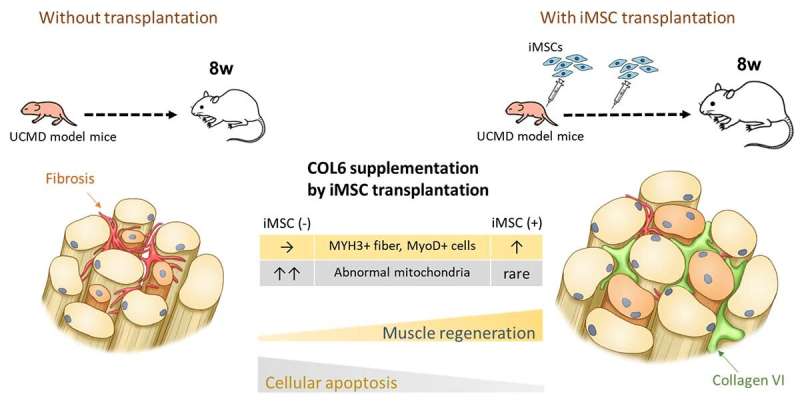The Hidetoshi Sakurai laboratory shows how iPS cells can replenish collagen VI to regenerate muscles in mice suffering from Ullrich congenital muscular dystrophy. Credit: Kyoto University
Muscle dystrophy describes a set of diseases that causes the weakening and loss of muscle. Ullrich congenital muscular dystrophy is a rare disease that is the result of a mutation in one or more three COL6 genes, resulting in the loss of the protein collagen VI. Patients begin to show severe muscle weakness shortly after birth and can struggle to breathe without a respirator before reaching school age. No cure exists, and all treatments are symptomatic, only slightly delaying the muscle degeneration.
In search of new therapies to treat Ullrich congenital muscular dystrophy, a new study from the Hidetoshi Sakurai laboratory at CiRA shows that the systemic injection of mesenchymal stromal cells, which were produced by manipulating human iPS cells, can regenerate muscle in mice suffering from the disease by partially recovering collagen VI. The results indicate the potential of cell therapies as a treatment option.
Collagen VI is essential for the integrity of muscle cells, and mutations in any of the three COL6 genes can lead to a spectrum of collagen VI deficiencies.
"There is evidence in animal models that collagen VI can be supplemented by mesenchymal stromal cell transplantation. We used iPS cells to produce enough mesenchymal stromal cells in order to systematically restore collagen VIfor a strong therapeutic effect," explains Dr. Aya Harada, the first author the study.
iPS cells are attractive for this cell therapy, because they eliminate the need for recruiting donors. Instead, they can be transformed into mesenchymal stromal cells used for the treatment.
Mouse pups showing Ullrich congenital muscular dystrophy symptoms are smaller in size than their healthy counterparts and also have lower levels of collagen VI in their muscles. The study found that iPSC-derived mesenchymal stromal cell transplantation into these mice caused a gain in muscle weight, larger muscle tissue, and better motor function.
Consistent with the increased muscle mass was evidence that the muscles could regenerate following the transplantation. Because of their constant use, muscles undergo regular wear and tear, which requires regeneration for their maintenance. In muscular dystrophy, including Ullrich congenital muscular dystrophy, muscles cannot regenerate at a rate that recovers from the wear and tear, resulting in progressive muscle loss.
Other factors besides the higher collagen VI levels were attributed to the benefits of the transplantation.
"Ullrich congenital muscular dystrophy leads to mitochondria dysfunction, which results in the apoptosis of muscle cells," said Harada.
Consistently, she found that the number of dysfunctional mitochondria seen in mouse muscle cells after the transplantation were significantly reduced.
CiRA Associate Professor Sakurai believes these findings provide a basis for developing cell therapies to treat Ullrich congenital muscular dystrophy.
"The collagen VI levels were very low compared with healthy mice, but they still showed a positive effect. Our observations suggest there is a critical time window for treatment," he said.
More information: Aya Harada et al, Systemic Supplementation of Collagen VI by Neonatal Transplantation of iPSC-Derived MSCs Improves Histological Phenotype and Function of Col6-Deficient Model Mice, Frontiers in Cell and Developmental Biology (2021). DOI: 10.3389/fcell.2021.790341
Provided by Kyoto University
























